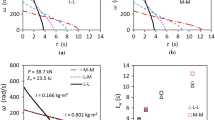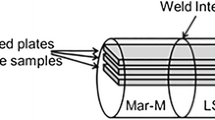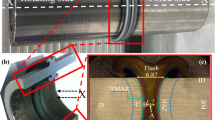Abstract
Finite element (FE) process modeling of inertia friction welding between dissimilar high-strength steels, AerMet® 100 and SCMV, has been carried out using the DEFORM™-2D (v10.0) software. This model was validated against experimental data collected for a test weld performed between the materials; this included process data such as upset and rotational velocities as well as thermal data collected during the process using embedded thermocouples. The as-welded hoop residual stress from the FE model was also compared with experimental measurements taken on the welded component using synchrotron X-ray and neutron diffraction techniques. The modeling work considered the solid-state phase transformations which occur in the steels, and the trends in the residual stress data were well replicated by the model.















Similar content being viewed by others

References
C. Weismann: Resistance and Solid State Welding and Other Ioining Processes, 7th ed., vol. 3. American Welding Society, Miami, 1976.
M. Preuss and P. Threadgill: in Solid State Welding of Aeroengine Materials. Encyclopedia of Aerospace Engineering 2010, Wiley, Chister, 2010.
W.S. Robotham, T.H. Hyde, E.J. Williams, P. Brown, I.R. McColl, and C.J. Kong: 4th Int. Conf. Adv. Exp. Mech., September 6, 2005–September 8, 2005, Southampton, UK: Trans Tech Publications, 2005.
Wang, K.K. and P. Nagappan: Weld. J., 1970, vol. 49, pp. 419–26.
Wang, K.K. and W. Lin: Weld. J., 1974, vol. 53, pp. 233–42.
V.R. Dave, M.J. Cola, and G.N. Hussen: Weld. J. Suppl, 2001, pp. 246–525.
A. Moal and E. Massoni: Eng. Comput., 1995, vol. 12, pp. 497–512.
A. Moal, E. Massoni, and J.-L. Chenot: Proc. Int. Conf. Comput. Plast., 1992.
K. Lee, A. Samant, W.T. Wu, and S. Srivatsa: NUMIFORM, 2001.
L. D’Alvise, E. Massonia, and S.J. Walløe: J. Mater. Process. Technol., 2002, vol. 125–126, pp. 387–91.
L. D’Alvise: Development of a finite element model for the simulation of the inertia friction welding process between dissimilar materials, 2002, MINES ParisTech, Paris.
L. Wang, M. Preuss, P.J. Withers, G. Baxter, and P. Wilson: Metall. Mater. Trans. B, 2005, vol. 36B, pp. 513–23.
B. Grant, M. Preuss, P.J. Withers, G. Baxter, and M. Rowlson: Mater. Sci. Eng. A, 2009, vol. 513–514(C), pp. 366–75.
C.J. Bennett, T.H. Hyde, and E.J. Williams: Proc. Inst. Mech. Eng., 2007, vol. 221(4), pp. 275–84.
A.H. Yaghi, T.H. Hyde, A.A. Becker, and W. Sun: Energy Mater., 2009, vol. 4(3), pp. 113–23.
M. Maalekian, E. Kozeschnik, H.P. Brantner, and H. Cerjak: Acta Mater., 2008, vol. 56(12), pp. 2843–55.
M.B. Mohammed, C.J. Bennett, P.H. Shipway, and T.H. Hyde: Optimization of Heat Transfer in the Finite Element Process Modelling of Inertia Friction Welding of SCMV and AerMet 100, in Heat Transfer 2010, Tallinn, Estonia, 2010.
M.B. Mohammed, C.J. Bennett, T.H. Hyde, and E.J. Williams: ASME Conf. Proc., 2009, vol. 48852, pp. 829–37.
I.S. Grigoriev, E.Z. Meilikhov, and A.A. Radzig: in Handbook of Physical Quantities, 1997, CRC-Press, Boca Raton, 1568.
C.J. Bennett: in Inertia Friction Welding of High Strength Aerospace Alloys, 2007, The University of Nottingham, Nottingham.
R.J. Moat, D.J. Hughes, A. Steuwer, N. Iqbal, M. Preuss, S.E. Bray, and M. Rawson: Metall. Mater. Trans. A, 2009, vol. 40A, pp. 2098–108.
Scientific Forming Technologies Corporation, DEFORM-2D Version 10.0 User’s Manual, J. Fluhrer, ed. 2009.
S. Bray: Internal Report, DHC333817, 2009, Rolls-Royce.
R. Moat, M. Karadge, M. Preuss, S. Bray, and M. Rawson: J. Mater. Process. Technol., 2008, vol. 204(1–3), pp. 48–58.
Acknowledgments
The authors would like to thank Rolls-Royce plc. The views expressed in this paper are those of the authors and not necessarily those of Rolls-Royce plc. The current study has been carried out under the PROMOTE project funded by The Technology Strategy Board, Rolls-Royce plc and Wilde Analysis Ltd. The Technology Strategy Board is a business-led executive nondepartmental public body, established by the government. Its mission is to promote and support research into, and development and exploitation of, technology and innovation for the benefit of the UK business, to increase economic growth and improve the quality of life. It is sponsored by the Department for Innovation, Universities and Skills (DIUS). Please visit www.innovateuk.org for further information.
Author information
Authors and Affiliations
Corresponding author
Additional information
Manuscript submitted September 5, 2012.
Rights and permissions
About this article
Cite this article
Bennett, C.J., Attallah, M.M., Preuss, M. et al. Finite Element Modeling of the Inertia Friction Welding of Dissimilar High-Strength Steels. Metall Mater Trans A 44, 5054–5064 (2013). https://doi.org/10.1007/s11661-013-1852-2
Published:
Issue Date:
DOI: https://doi.org/10.1007/s11661-013-1852-2



